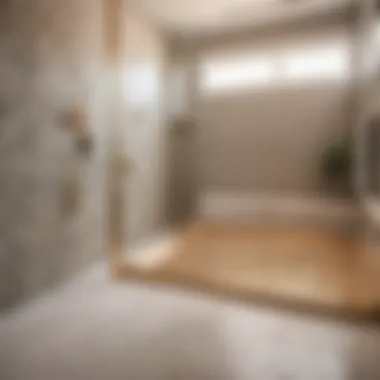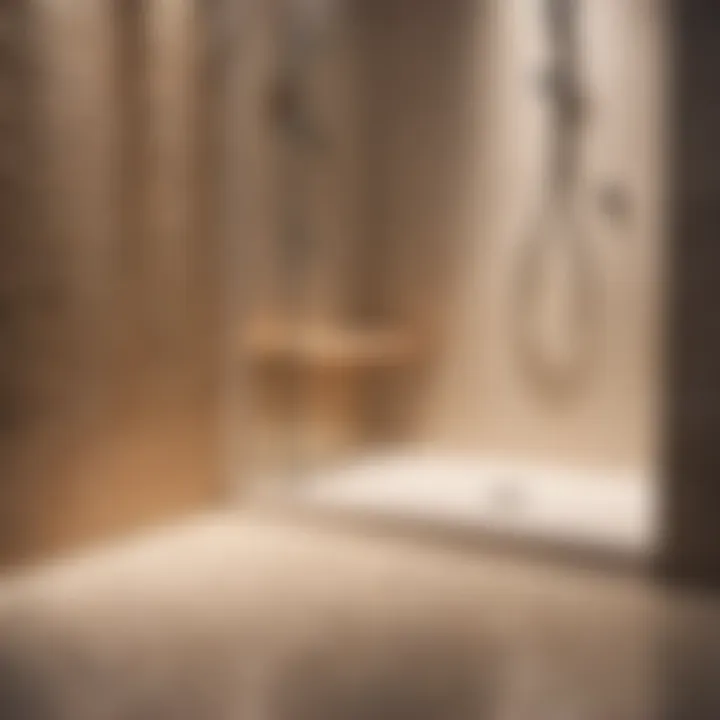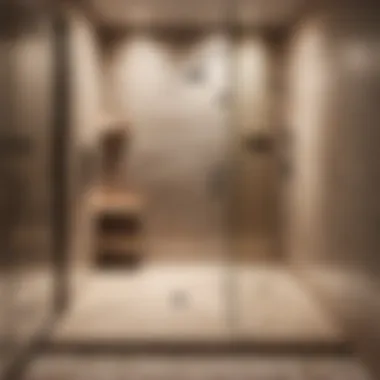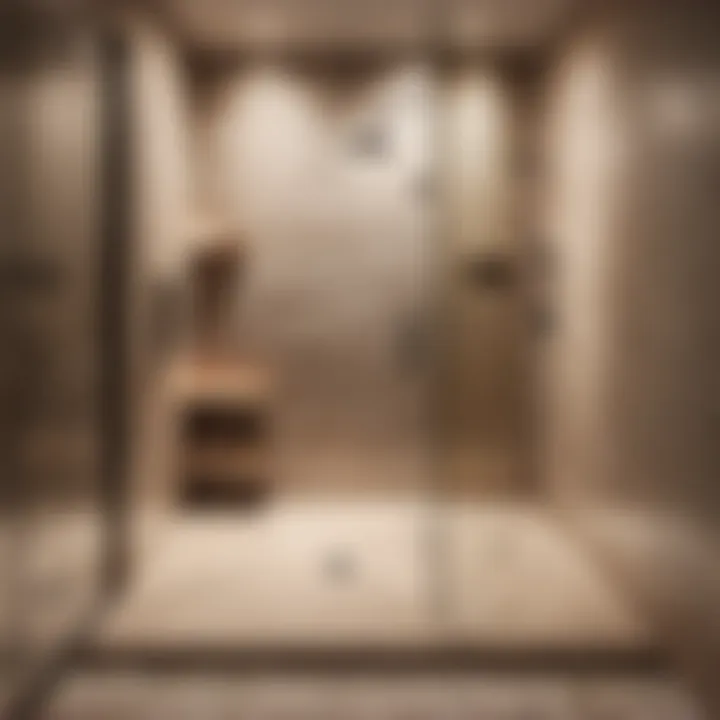Materials:
- Shower base kit including base, drain, and instructions. Ensure the dimensions fit your space accurately.
- Level
- Tape measure
- Adjustable wrench
- Pencil
- Waterproofing membrane
- Mortar
DIY Steps:
- Begin by measuring the area where the shower base will go and ensuring it fits properly.
- Install the drain according to the manufacturer's instructions.
- Apply the waterproofing membrane around the perimeter where the base will sit.
- Mix and apply the mortar to create a level base for the shower.
- Set the base in place, ensuring it is level and securely positioned.
Technical Aspects:
- Tools: Level, tape measure, adjustable wrench.
- Timing: Allow sufficient time for mortar to set.
- Critical Techniques: Ensuring proper measurements and a level base are crucial for a successful installation.
DIY Project Process:


- Prepare the area by cleaning and ensuring it is level and dry.
- Follow manufacturer instructions for specific installation steps.
- Double-check measurements and levels throughout the process.
- Troubleshooting Tips: If the base is not level, adjust the mortar accordingly for a stable foundation.
Pre-Installation Preparations


Before diving into the installation of a shower base, proper pre-installation preparations are crucial for a successful outcome. This section focuses on gathering necessary tools and materials, measuring and marking the installation area, and checking the sub-floor condition.
Gather Necessary Tools and Materials
Shower Base
The shower base, also known as a shower pan, serves as the foundation of the shower floor. It is essential in ensuring proper water drainage and preventing leaks. Choose a high-quality shower base that fits the dimensions of your shower area to avoid installation issues. Opt for durable materials like acrylic or fiberglass that are resistant to mold and mildew, ensuring longevity.
Level
A level is critical for ensuring that the shower base is installed correctly and efficiently. It helps maintain a perfectly horizontal surface, eliminating any potential sloping or unevenness in the base. A properly leveled base ensures proper water drainage towards the drain, preventing water pooling and potential water damage.
Measuring Tape
A measuring tape is indispensable for accurately determining the dimensions of your shower area and ensuring that the shower base fits snugly. Measure twice to avoid any costly mistakes or the need for unnecessary adjustments during the installation process. The accuracy of measurements directly impacts the overall installation quality.
Adhesive
Adhesive is used to bond the shower base to the sub-floor securely. Choose a high-quality waterproof adhesive suitable for the material of your shower base to ensure a strong and lasting bond. Proper application of adhesive is crucial to prevent shifting or movement of the base over time.
Screws
Screws are essential for anchoring the shower base to the sub-floor, providing additional stability and support. Select corrosion-resistant screws that can withstand moisture and constant use in a wet environment. Ensure proper placement and tightening of screws to reinforce the shower base's connection and prevent any structural issues.
Installing the Shower Base


When it comes to installing a shower base, meticulous attention must be paid throughout the process to ensure a durable and functional outcome. This section of the article delves deep into the essential steps involved in placing the foundation of your shower, setting the stage for a successful bathroom renovation.
Apply Adhesive and Position the Base
Applying adhesive and correctly positioning the base are crucial tasks that lay the foundation for a sturdy and leak-proof shower. The adhesive acts as the bonding agent, securing the base firmly in its place. By spreading the adhesive evenly, you ensure maximum contact between the base and the floor, minimizing any chances of movement or gaps that could lead to leaks.
Spread Adhesive Evenly
In this step, the even distribution of adhesive is paramount for the stability and longevity of the shower base. Ensuring a uniform layer of adhesive across the entire contact surface prevents uneven stress points that may compromise the base's integrity over time. This method of installation not only enhances the structural robustness but also minimizes the risk of water seepage.
Set Base in Place
Positioning the base accurately is fundamental to a successful installation. Placing the base securely in its designated spot guarantees a level surface for the rest of the shower components to align correctly. By setting the base firmly in place right from the start, you lay a solid groundwork for the entire shower enclosure, eliminating potential issues down the line.
Secure the Base
Securing the base involves finalizing its attachment to the subfloor, ensuring a stable and safe foundation for the shower structure. Using screws to fasten the base adds an extra layer of security, preventing any shifting or movement that could compromise the overall integrity.
Use Screws
Screws play a crucial role in anchoring the base to the subfloor, providing a reliable connection that withstands daily use and prevents loosening over time. Opting for corrosion-resistant screws further enhances the base's durability, especially in wet environments like the shower.
Check for Stability
After securing the base, conducting a thorough stability check is imperative to confirm its robustness. Verifying that the base is firmly in place and free from any wobbling ensures a safe showering experience for years to come. By prioritizing stability, you guarantee a solid foundation for the rest of the shower installation.
Connect the Drain
Connecting the drain components marks a critical stage in finalizing the shower base installation, paving the way for functional drainage and leak prevention.
Attach Drain Components
Properly attaching the drain components ensures seamless water flow and effective waste disposal. Creating a watertight seal around the drain prevents any leaks that could potentially damage the subfloor or surrounding areas. This meticulous process is essential for maintaining the shower's integrity over time.
Test for Leaks
Before considering the installation complete, thorough testing for leaks is vital to identify and rectify any potential issues. Running water through the drain system and observing for any seepage confirms the success of the installation. This meticulous approach guarantees a watertight shower base, ready to withstand daily use without any concerns.
These detailed steps provide a comprehensive overview of installing a shower base, guiding you from preparation to enjoying the reliable and robust results of your bathroom upgrade.
Finishing Touches
After successfully installing the shower base, the finishing touches play a crucial role in ensuring the longevity and effectiveness of your project. Paying attention to the details when sealing edges and joints, testing the shower base, and carrying out the final clean-up will not only enhance the aesthetic appeal but also prevent potential issues down the line.
Seal Edges and Joints
Apply Caulk
When it comes to applying caulk, precision and expertise are key. Caulk serves as a barrier against water infiltration, protecting the structural integrity of your shower base. Opting for a high-quality caulk that is waterproof and mold-resistant will ensure a durable seal. The flexibility of caulk allows it to expand and contract with the shower base, preventing cracks and leaks. Its ease of application and quick drying time make it a popular choice among homeowners looking for a reliable sealing solution.
Smooth Out
Smoothing out the caulk after application is a crucial step to ensure a seamless finish. Using a caulk tool or damp cloth, gently glide over the applied caulk to create a uniform and neat appearance. This smooth finish not only enhances the visual appeal of the shower base but also reinforces the seal, reducing the likelihood of moisture seepage and mold growth. Taking the time to smooth out the caulk will result in a professional-looking installation that is both functional and aesthetically pleasing.
Test the Shower Base
Run Water
Running water in the shower base is a vital step to check for leaks and proper drainage. By allowing water to flow through the system, you can identify any potential issues such as leaks around the edges or improper slope towards the drain. Observing how the water behaves on the base will help evaluate the effectiveness of the installation and make necessary adjustments before finalizing the project.
Check Drain
Inspecting the drain for any obstructions or leaks is essential to ensure the proper functioning of the shower base. Checking that the drain components are securely connected and sealed will prevent water damage and potential flooding. By verifying the drainage system's efficiency, you can guarantee a hassle-free shower experience without the risk of water accumulation or drainage problems.
Clean Up
Remove Excess Materials
Removing excess materials such as adhesive, caulk, and debris is crucial to achieving a polished final look. Thoroughly clean the surrounding area of the shower base to eliminate any residues that may detract from the overall appearance. A clean workspace not only enhances the aesthetics but also reflects your attention to detail and commitment to a successful installation.
Dispose Properly
Disposing of construction waste and unused materials responsibly is a final step that should not be overlooked. Follow local regulations for proper waste disposal to maintain a clean environment and contribute to sustainability. By disposing of materials in an eco-friendly manner, you demonstrate environmental awareness and respect for your surroundings, ensuring a positive impact beyond your newly installed shower base.





